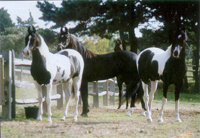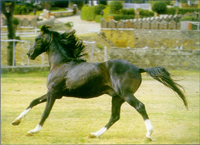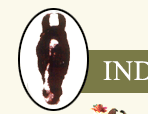

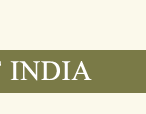
|
The
Horse Breed Standards
THE MARWARI HORSE BREED STANDARD
There is only one standard for type and conforruation of the Marwari Horse. TYPE : Type is the ideal or standard of perfection for the breed. In addition to its physical characteristics, the Marwari is defined by its personality and vigour, handsome forthright presence and arrogant bearing in the stallion and doe eyed beauty in the mare. CONFORMATION: Conformation is the degree of perfection of the component parts and their harmonious relationship to each other. THE HEAD: The head conveys the undefinable oriental presence of the horse and should be expressive with a high forehead, large sparkling prominent eyes, straight or slightly Roman long face giving a clean chiseled profile and well rounded defined jaws, the nostrils are large and gently flared set over firm fine lips and an even bite. The ears should be of medium length and shapely, curving and curling inwards at their points in a scimitar or lyre shape typical to the breed. They will be somewhat longer in the mare.
THE NECK: MAYURA GREEVA , proud as a peacock. The neck should come out from an extremely well angulated shoulder with good breadth from top of the withers to the point of shoulder. It should neither be thickset or narrow but arched, well muscled and tapering in relation to sex. It should blend easily without break into the withers and back . Additionally it should be sethigh enough to allow proper head position well above the lines of the withers and to display to advantage the " Marwari look" which is predicated upon the way the neck grows out of the back. The stallion should have more crest than the mare or gelding. THE WITHERS should be well defined and in proportion to the angulation of the shoulder. THE CHEST on the Marwari is not particularly broad, but it should be well developed and a weak or narrow chest considered a severe fault.
THE FRONT LEGS should be straight and sound with flat bone, good length of forearm and a shorter cannon. The cannon bones are strong and slender, and the pasterns of sufficient length and angulation to provide a light, flexible and springy step. The knee bones should be flat and the feet in proportion to the size of the horse, round open at the heel with concave soles, and sound.
The conformation of THE REAR LEGS is extremely important. Any weakness in standing or movement should be considered a fault, such as cow hock, sickle hock etc. Lack of proper smooth flexion of the hock and stifle should not be tolerated in breeding stock or show horses. Viewed from the rear, the croup should be well rounded. Thighs and gaskin should be muscular and full. The legs should be seen to carry the horse squarely and upright. Like the forearm, the gaskin will be relatively longer than the cannon. THE HEIGHT of the Marwari Horse will range from 14.2 hands to 15.2 with some exceptions either way. Horses should be serviceably sound. Stallions must be masculine in appearance and mares must be feminine. The coat should be smooth, fine and silky in appearance. COAT OR EYE COLOUR shall have no bearing on the breed standard except in a few instances; the albino is bred in India specifically for religious use and is not acceptable in the breed standard. The Nukra or Cremello horse may be acceptable, if of exceptional type and conformation. While the distinctive metallic bright bay is highly desirable, the flat chestnut colouring is a result of interbreeding with non oriental foreign imports and should not be considered for show or breeding stock. THE GAITS : Should be performed with great style, collection and lightness of' motion. The walk should be flat footed, free, rapid, elastic and ground covering. Horses must show purpose and intent to travel forward without undue restraint or aids. The trot should be an elevant balanccd trot with ail enhanced precise natural action with sufficient speed to be ground covering but with enough collection to maintain the speed for extended periods of time. Overall graceful form should not be sacrificed for speed or for height of action alone. The Revaal qualifies the Marwari Horse as a "gaited " horse although this action is act found in all individuals and does not impact the breed standard in any way. The movement must not include paddling, winging or landing on the heels. Any horse with revaal scars on the rear of the pastern should be penalized as should be unnatural movement, characteristically produced by excessive use of shackles, hobbling over and under riding and poor training methods.
The canter should be smooth. collccted and straight oil both lead.s at all times. The Marwari should be able to achieve a full gallop from standing start and stop on command. He should be able to reverse with ease, and at all times display the bold and fearless presence of the breed. |

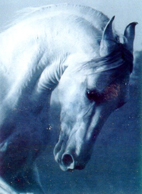

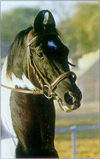 THE
THROAT - LATCH is deep and sufficiently refined to allow proper
flexion and normal respiration at all times in all movements.
THE
THROAT - LATCH is deep and sufficiently refined to allow proper
flexion and normal respiration at all times in all movements.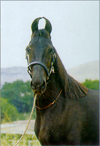 THE
BODY should be compact and rounded with a medium to short
back and close coupling, well sprung ribs and deep loins.
The croup is long and well muscled with the tail attached
high and curved gracefully. A low back is a fault and the
Marwari should not be higher at the rump than at the withers.
Viewed from the side the top line presents a sensual curve
from the poll to the straight back rounding into the thigh.
The neck should give the impression of sitting on top of the
withers rather than in front of them. The underline should
be long and deep through the heartgirth and flanks. The extreme
angulation of the shoulder place the front legs further forward
on the body. The front legs are straight and perpendicular
to the ground, as are the rear cannons when points of hock
and buttock are in the same vertical line. The stifle should
be placed well forward and low in the flank area.
THE
BODY should be compact and rounded with a medium to short
back and close coupling, well sprung ribs and deep loins.
The croup is long and well muscled with the tail attached
high and curved gracefully. A low back is a fault and the
Marwari should not be higher at the rump than at the withers.
Viewed from the side the top line presents a sensual curve
from the poll to the straight back rounding into the thigh.
The neck should give the impression of sitting on top of the
withers rather than in front of them. The underline should
be long and deep through the heartgirth and flanks. The extreme
angulation of the shoulder place the front legs further forward
on the body. The front legs are straight and perpendicular
to the ground, as are the rear cannons when points of hock
and buttock are in the same vertical line. The stifle should
be placed well forward and low in the flank area.